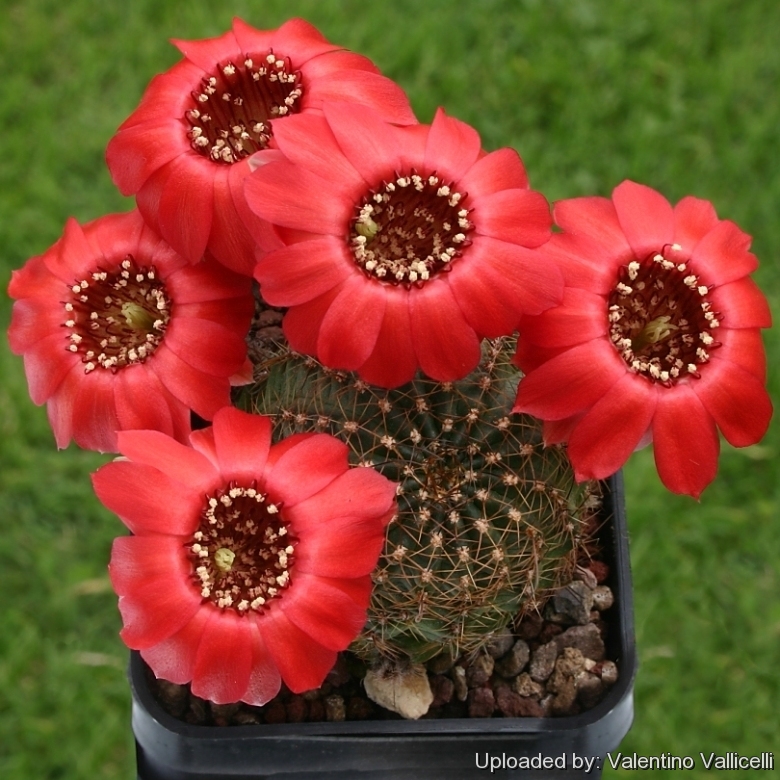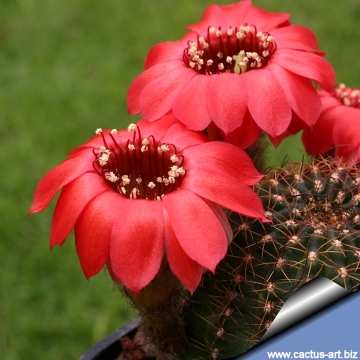= Echinopsis saltensis var. nealeana (Backeb.) J.G.Lamb.
Cact. d'Argentine ed. 2 65. 1997 1998 J.G.Lamb.
Accepted Scientific Name: Echinopsis saltensis Speg.
Anales Mus. Nac. Buenos Aires ser. 3, 4: 487. 1905

Lobivia nealeana (Echinopsis saltensis var. nealeana) Photo by: Valentino Vallicelli
This plant has usually somewhat larger solitary body than the near L. saltensis var. pseudocachensis, sometimes with long, curved central spines.
Origin and Habitat: Tucumán, Salta, nothern Argentina
Synonyms:
See all synonyms of Echinopsis saltensis
Description: Echinopsis saltensisSN|16319]]SN|16319]] var. nealeana was firstly described as a variety of Lobivia nealeanaSN|16332]]SN|16332]] Its appearance is very much like that of standard Lobivia nealeanaSN|16332]]SN|16332]] but shows a somewhat larger solitary body, sometimes also with long, curved Central-spines, the red blooms are more spread and rarely yellow too. The fruit and seed are similar to those of the other Varieties.
Habit: Small cactus, usually solitary, or heavily clustering.
Stem: Flattish, egg-shaped or slightly elongated, up to 12 cm tall, 9 cm in diameter, bright green to dark green or almost black.
Areoles: 5-7 mm apart.
Ribs: 17-20 (or more).
Roots: Tap root.
Radial spines: 10-14 Thin, reddish.
Central spines: 0 - 4 whisker-like, twisted, asymmetrical, more or less long, interlaced up and disorderly curved up to 3 cm long (This taxon comprises both individuals with or without central spines). The length of these spines greatly depends on sun exposure and plant's age.
Flowers: Pretty, shining, small up to 5 cm long, unscented, somewhat bell-shaped-bulgy, dark orange-red or crimson that appears almost black when starting to open. The stamen's filaments are dark red, and bear cream-white contrasting anthers. The stigma lobes are greenish.
Blooming season: The greater part of flowers appears in spring in the first flowering, but the plant can erratically produce some flowers in summer too.
Fruits: Globular, 5 mm in diameter, with little brown wool, up-drying.
Seeds: Globular, small grained.
More...Subspecies, varieties, forms and cultivars of plants belonging to the Echinopsis saltensis group
- Echinopsis cachensis Speg.
 Echinopsis saltensis Speg.: (subsp. saltensis) Plants with relatively short petals and dark-coloured Stamens. Origin between Tucuman and Salta ( from Alemania to close to Cafayate).
Echinopsis saltensis Speg.: (subsp. saltensis) Plants with relatively short petals and dark-coloured Stamens. Origin between Tucuman and Salta ( from Alemania to close to Cafayate). Echinopsis saltensis var. nealeana (Backeb.) J.G.Lamb.: This plant has usually somewhat larger solitary body than the near var. pseudocachensis, sometimes also with long, curved Central-spines, the red blooms are more spread and rarely yellow too. The fruit and seed are similar to those of the other Varieties.
Echinopsis saltensis var. nealeana (Backeb.) J.G.Lamb.: This plant has usually somewhat larger solitary body than the near var. pseudocachensis, sometimes also with long, curved Central-spines, the red blooms are more spread and rarely yellow too. The fruit and seed are similar to those of the other Varieties.- Echinopsis saltensis var. pseudocachensis (Backeb.) J.G.Lamb.: Only a few cm small, clumping green bodies, with a long carrot root. Ribs about 14 straight. The plants in this population are quite variable and comprises both individuals with long central spines and individuals with short radial spines without central (Respectively named Echinopsis saltensis var. emmae and Echinopsis saltensis var. emmae f. brevispina) The flower is 4-6 cm long and broad, light red to carmine coloured. The fruit and seed are similar to those of the other Varieties. Origin: Escoype.
 Echinopsis saltensis subs. schreiteri (A.Cast.) M.Lowry: has small deep-rooted, clustering stems. Flowers, short-tubed, red and purple to 3 cm long with sharp tipped petals and reddish purple stamens. Distribution: between Tucuman and Salta in north-western Argentina.
Echinopsis saltensis subs. schreiteri (A.Cast.) M.Lowry: has small deep-rooted, clustering stems. Flowers, short-tubed, red and purple to 3 cm long with sharp tipped petals and reddish purple stamens. Distribution: between Tucuman and Salta in north-western Argentina.- Lobivia emmae var. brevispina Backeb.
- Lobivia saltensis var. emmae (Backeb.) G.D.Rowley
 Lobivia saltensis var. multicostata Rausch: The plant of this population are similar to Lobivia saltensis, however with 20 and more ribs, closer spaced areoles and therefore also closer, broom-like Spination. Flower and fruit are alike. Origin: Cuesta de Lajar.
Lobivia saltensis var. multicostata Rausch: The plant of this population are similar to Lobivia saltensis, however with 20 and more ribs, closer spaced areoles and therefore also closer, broom-like Spination. Flower and fruit are alike. Origin: Cuesta de Lajar. Lobivia saltensis var. zapallarensis Rausch: This is the smallest form from the Sierra Zapallar it has only 9-11 sharp-edged ribs, the epidermis is black-green, often also violet coloured with red to orange flowers, the fruit is more oval, however otherwise nearly like Lobivia saltensis.
Lobivia saltensis var. zapallarensis Rausch: This is the smallest form from the Sierra Zapallar it has only 9-11 sharp-edged ribs, the epidermis is black-green, often also violet coloured with red to orange flowers, the fruit is more oval, however otherwise nearly like Lobivia saltensis.
Bibliography: Major references and further lectures
5) Edward Anderson “The Cactus family” Timber Press, Incorporated, 2001
6) James Cullen, Sabina G. Knees, H. Suzanne Cubey "The European Garden Flora Flowering Plants: A Manual for the Identification of Plants Cultivated in Europe, Both Out-of-Doors and Under Glass" Cambridge University Press, 11/Aug/2011
2) David R Hunt; Nigel P Taylor; Graham Charles; International Cactaceae Systematics Group. "The New Cactus Lexicon" dh books, 2006
4) Friedrich Ritter "Kakteen in Südamerika: Ergebnisse meiner 20jährigen" Volume 2, Argentinien/Bolivien, Volume 2 Selbstverlag, 1980
5) Curt Backeberg “Die Cactaceae: Handbuch der Kakteenkunde,” Volume 2 G. Fischer, 1959
7) Walter Rausch “Lobivia: The Day Flowering Echinopsidinae from a Geographical Distribution Point of View” Volumes 1-3 R. Herzig, 1975
8) Urs Eggli, Leonard E. Newton “Etymological Dictionary of Succulent Plant Names.” Springer, Berlin/Heidelberg 2010.
9) N. L. Britton and J. N. Rose “The 'Cactaceae', Descriptions and Illustrations of Plants of the 'Cactus' Family” volume 2 Carnegie Institution, 1920
10) Ortega-Baes, P. & Méndez, E. 2013. Echinopsis saltensis. In: IUCN 2013. “IUCN Red List of Threatened Species.” Version 2013.1. <www.iucnredlist.org>. Downloaded on 31 October 2013.
More... Lobivia nealeana (Echinopsis saltensis var. nealeana) Photo by: Cactus Art
Lobivia nealeana (Echinopsis saltensis var. nealeana) Photo by: Cactus ArtSend a photo of this plant.The gallery now contains thousands of pictures, however it is possible to do even more. We are, of course, seeking photos of species not yet shown in the gallery but not only that, we are also looking for better pictures than those already present.
Read More... Cultivation and Propagation: It is a summer grower species that offers no cultivation difficulties. Lobivia saltensisSN|16320]]SN|16320]] has a fairly large tap root, and should be kept in a deep pot with a very draining mineral substrate. Water regularly in summer (but do not overwater ) keep dry in winter. Feed with a high potassium fertilizer in summer. Repot yearly until reaching about 100 mm in size, then every two or three years will suffice. Repotting is best done at the end of winter but can be done at other times. Do not water for a couple of weeks after repotting to reduce risk of root rot via broken roots. Repotting will increase size of stems. It is quite cold tolerant if kept dry (hardy to -5° C). Outside it need a bright exposure, full sun or half shade in summer, inside it needs bright light, and some direct sun.
Propagation: Seed, grafting, cutting.
More...











